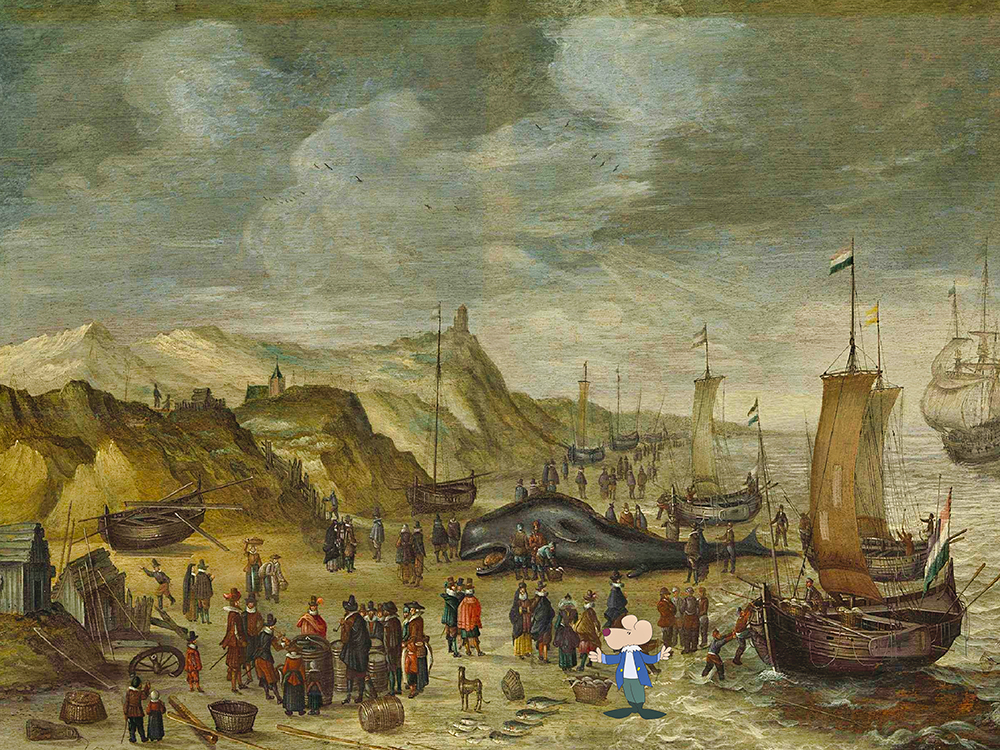Clearly, the whale was having a bad day. I got a little sad for that whale and for all the others that had run into such a predicament. As I was reading my “This Day in History” letter, the entry for today’s date in 1614 simply said, “1614 Sperm whale beached at Noordwijk.” Of course, all sorts of things came to mind. The first thought? This must have been the first time this ever happened in Noordwijk.
Unless you are some geography genius, Noordwijk is a town and municipality in the west of the Netherlands, in the province of South Holland.
Noordwijk is pronounced Noordwijk, if you are trying, like me.
The municipality covers an area of 28.9 square miles, of which 6.4 square miles is water. Today, the beach seems to be the biggest attraction of the town, and it appeared the same way back in 1614.
I know this because someone thought so much of the “Beached Whale Incident” that he made a painting. Yes. The actual title is: “A Sperm Whale Washed up on the Beach at Noordwijk, 28 December 1614.”
It was painted, an oil on panel, by a man named Hans Savery. The painting isn’t huge by any means, but large enough. It is 20 inches by 33 inches. Today, it hangs in the Rijksmuseum. I’ve been there on my second trip to Amsterdam, but I don’t remember seeing “Sperm Whale.” At any rate, it says the creation date is 1614 – 1626. That’s some slow painting.
But again, I had to wonder. Was Hans overcome by the event? Or did someone say to him, “Hans, old buddy, I want you to paint the big whale on the beach incident.” His full name was Hans Savery the Younger, a Dutch painter who lived from 1597–1654. I bet his dad was named Hans the Older.
It could have been the whale, I suppose. Some sort of omen in the Dutch culture. Those sperm whales have the biggest brains on the planet by the way. The human brain runs about three pounds in weight. The sperm whale has 17 pounds of thinker in its head.
And their name comes from a “white waxy material” they produce. The early whalers thought it was sperm, hence the name. But now, that material has been tested, and no one can figure out why the sperm whale produces it. The gunk comes from a barrel-like organ inside the whale’s head. Probably near its big-o brain. They think it might be a “buoyancy” thing or some sort of “shock-absorber” or something to do with their “vocals.” But science hasn’t figured that one out yet.
I think it has to do with how deep they dive. Sperm whales have been recorded descending to depths of over 3,280 feet. And. They can hold their breath for 90 minutes and beyond.
By the way, if you’ve ever read Moby Dick, you have a sperm whale to thank. The book was based on an actual incident involving a sperm whale. The entire scene unfolded in the South Pacific on November 20, 1820. It was an enraged male sperm whale. He kept slamming into a whaling vessel called The Essex. That angry whale beat the boat to pieces. My guess? He’d seen those boys kill too many of his friends. Don’t make large-brained sperm whales angry, FYI.
But none of this explains the entry in “This History Day” — 1614, Beached Whale. Upon further digging, I found that between 1521 and the end of the seventeenth century, there were at least forty instances of whales becoming stranded on the coasts of the Netherlands. Probably because of the tricky nature of the North Sea coastline for the enormous whales. Scientists think their echo-sounding system was possibly disrupted by the muddy, sloping shore areas.
But the people back then thought it was a highly significant event — a “sign” from above. They viewed them as “oracular signposts” or portents of impending disaster.
So, yes. A little whale history, from the deep, dark past.
And.
I know a whale joke.
It’s a real killer.
==========
“It is life, I think, to watch the water. A man can learn so many things.”
― Nicholas Sparks, The Notebook
==========
“Human nature is like water. It takes the shape of its container.”
― Wallace Stevens
==========
“Ignorance is the parent of fear.”
― Herman Melville, Moby-Dick or, the Whale
==========
Thar she blows. But why paint about it?
